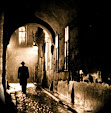
Last year’s The House of the Devil plays like an unreleased Tobe Hooper flick from 1980—the kind of movie he might of made in that forgotten period between The Texas Chainsaw Massacre and Poltergeist. I don’t just mean that it apes the style of those films. I mean that it tries to present itself as one of them, right down to its retro poster and opening titles. In a humorous nod to the later 80s, there’s even a Footloose-inspired dance scene (set to none other than The Fixx’s “One Thing Leads to Another). While it’s good for a laugh, all this can easily be written off as Grindhouse-style homage, yet another chapter in the increasingly annoying modern obsession with 80s culture. What’s surprising, then, is how well The House of the Devil manages to match those late 70s/early 80s horror classics in tone and style. Those directors (Hooper, John Carpenter, Wes Craven) prized suspense and build-up above all else. They were always giving the viewers a chance to scare themselves before they allowed the movie to do it for them. The House of the Devil picks up where those old masters of the genre left off—when was the last time somebody actually made a “stuck in a scary house” movie?—and the result is a surprisingly creepy little artifact of a film.
In keeping with the old-school horror style, The House of the Devil is downright slow for its first third. We follow Sam (Jocelin Donahue), a college student who’s dealing with the very everyday problem of having an annoying roommate. She’s found her dream apartment, but she only has a matter of days to get money for the down payment. Her desperate situation leads her to seek out an “easy” gig as a babysitter along with her best friend Megan (mumblecore queen Greta Gerwig, whose feel for meandering, realistic conversation actually fits into this milieu quite perfectly). These first 30 minutes do move by pretty uneventfully, but when the two arrive at the house for the babysitting gig—a byzantine mansion that looks more like a life-sized dollhouse than a place anyone would actually live—only to find that the couple in question doesn’t even have a kid, we know things are about to get weird.
This slow-burning approach is a big part of what makes The House of the Devil work so well. Like Michael Haneke’s Funny Games, this is a film that wrings a lot of creep out of characters finding themselves in situations that slowly move from just plain old socially awkward to quietly terrifying. This is most apparent during Sam’s meeting with the owner of the house, Mr. Ulman (Tom Noonan), an impossibly tall old man whose strangely passive demeanor only makes every pleasantry and overly polite remark he makes sound like a veiled threat. Noonan’s an old pro, and he’s perfectly subtle in the role, to the point that you don’t even blame Sam for eventually taking the job—especially after Mr. Ulman ups the pay to a few hundred bucks for an evening’s work.
Once Sam is left alone in the house—except for “Mother,” that is, who may or may not be sleeping in a bedroom upstairs—is when The House of the Devil really comes into its own. The film was produced by Larry Fessenden’s (The Last Winter, Wendigo) production outfit Glass Eye Pix, and like Fessenden, director Ti West has a real gift for pushing tension and mystery as far as it can possibly go. In this regard he owes as much to Hitchcock and Polanski as he does to guys like Carpenter and Romero, especially in the way he makes use of classical suspense (that is, the things the audience knows that the characters onscreen don’t) as way of building a sense of dread. He also manages to get an absurd amount of mileage out of some well-worn horror gags, from power outages and unsourced sounds to everyone’s favorite, the obscenely loud telephone that rings at just the right moment. Using every trick to its full potential, West manages to create one of the best 30 minutes of old-fashioned big screen horror I’ve seen in a long time. It's a movie that prizes atmosphere and suspense over gore, where every little bump in the night carries with it some real dramatic weight. Of course, when the violence does come, it’s quick and downright brutal, not unlike the first appearance of Leatherface in the original Texas Chainsaw Massacre.
Like most movies that work on suspense, The House of the Devil inevitably brings on a bit of a letdown when it finally lays its cards on the table. This is disappointing, but at the same time it’s a testament to how well West and company were able to build atmosphere: there was simply no way they could ever live up to the creepy bar they set for themselves. Still, none of this takes away from the kind of wonderfully low-budget horror this film achieves. It’s a classically made movie that deserves credit for not just stealing from the old school, but for taking ownership of the kind of style and approach that made those movies great. It harks back to the days when directors like Romero, Carpenter, and Hooper were king, and for horror fans there’s no way that can be a bad thing.


No comments:
Post a Comment